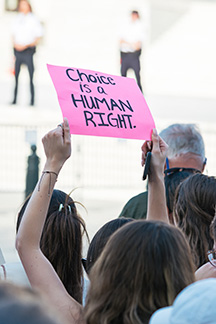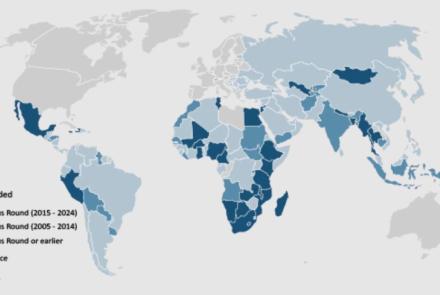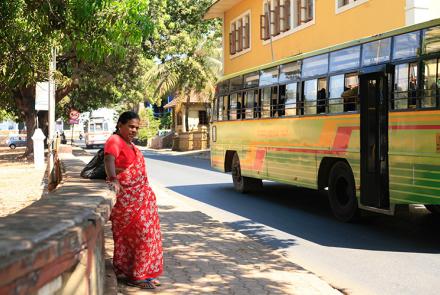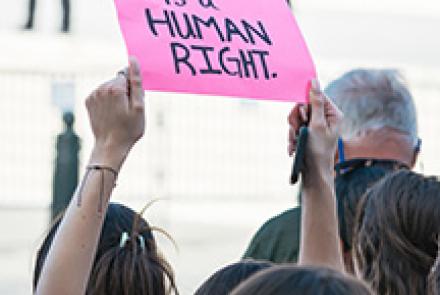ROE V. WADE: A STRUGGLE FOR AMERICA'S FUTURE
By Sonalde Desai
The United States Supreme Court has overturned its own 1973 ruling regarding women’s right to privacy as they seek abortion. The 1973 judgment in Roe v. Wade, was a landmark judgment in which the U.S. Supreme Court on January 22, 1973, ruled (7–2) that unduly restrictive state regulation of abortion is unconstitutional. Because this judgment has been overturned, states are now free to enact their own legislation regulating access to abortion. According to The New York Times, eight states have already banned abortion, with four more banning the procedure at six weeks. In addition, there are several more states that are preparing to ban or severely restrict abortions.
The crisis around the right to obtain legal abortion has been brewing for a while. For the Christian right, it is a matter of sanctity of life; for women’s rights activists, it is a matter of women’s control over their bodies. The PEW Research Center estimates that about 61% of the Americans favor abortion being legal under most conditions whereas 37% say it should be illegal in most conditions. Support for making abortion illegal comes from evangelical white protestants and individuals ages 30 and above, while younger and more educated individuals support continued access to abortion.
While this fight is shaped around competing claims of protecting life vs. reproductive rights, it is important to consider empirical research documenting two separate but related trends as we evaluate these claims.
The first set of studies examines the impact of the legalization of abortion in 1973 on the lives of individuals. Multiple studies found that the legalization of abortion was associated with a decline in American fertility. For example, Cailyn Myers in a study published in the Journal of Political Economy found that abortion legalization reduced the number of women who became teen mothers by 34% and the number who became teen brides by 20%, moreover these effects were even larger for Black teens. Many studies, including one by the 2022 Nobel Prize recipient Joshua Angrist, also found that abortion legalization increased women’s education, labor force participation, occupational prestige, and earnings and that all these effects were particularly large for Black women.
The second set of studies shows that reliance on abortion has declined substantially over the past two decades. The Guttmacher Institute estimates that abortion rates in the United States have reached historic lows. In 1973, before Roe v. Wade, the abortion rate was 16.3 per 1000 women ages 15-44, it rose to 29.3 in 1981 and declined to 13.5 by 2017. This decline occurred as contraceptive access grew, particularly with increased access to long-acting reversible methods of contraception such as injectables, implants and IUDs.
Several factors played a role in improved access to contraception. Improved contraceptive technologies led to increased choice in contraceptives. Moreover, US government policies played a major role in improving contraceptive access for the young and the poor. The Affordable Care Act, passed under Obama administration, mandated all health insurance providers to cover contraceptive costs, sharply reducing out-of-pocket costs for contraception. It also increased coverage for young people on their parents’ insurance. Joelle Abramowitz from the University of Michigan estimates that when women ages 20-24 were able to stay on their parent's insurance, the rate of abortions in this age group fell by between 9 and 14 per cent compared to women who weren't able to access that eligibility.
While improved access to contraception may reduce unplanned pregnancies and thereby reduce abortion, research also shows that it may not be sufficient to eliminate all unplanned pregnancies. Data on contraceptive failure in the United States compiled by the Guttmacher Institute shows that under typical use, about 7% of individuals relying on contraceptive pills and 13% using condoms will become pregnant within a year. These are the methods that most younger Americans use.
Moreover, life is full of unexpected turns, especially for young women. In a longitudinal study of relationship dynamics for women ages 18-19 in Michigan, sociologists Jennifer Barber and Heather Gatny found that 2/3 of the young women who were positive about having a child before pregnancy, felt negative about their pregnancies after the fact, mainly because their partners reacted negatively to the pregnancy. In more extreme cases, women may also be subjected to reproductive coercion where their partners engage in a range of behaviours that restrict reproductive autonomy including pregnancy coercion, birth control sabotage, and controlling the outcome of a pregnancy. Research on this is more limited but available studies suggest that the experience of reproductive coercion is higher among younger women, women with less education and Hispanic women.
Overturning Roe v. Wade and leaving legislation about abortion to state legislatures will simply exacerbate these inequalities. The experience of individuals living in the State of Texas foreshadows some of the potential effects. In September 2021, Texas passed a law that prohibits abortions whenever an ultrasound can detect what lawmakers defined as a fetal “heartbeat,” often at 6 weeks of pregnancy. Researchers from the University of Texas found that many women were forced to seek abortions out of state. Even for those who were able to obtain abortions out of state, a number of hurdles persisted including, difficulties scheduling appointments in Texas while they were still eligible for in-state care; visits to pregnancy resource centers that discouraged abortion; limited availability of timely out-of-state appointments because of increased patient volume; complicated travel logistics that involved long journeys and overnight drives, and increased economic hardship, including lost wages, paying for gas and food, and overnight stays for multiple days.
Now that Roe v. Wade is overturned and regulation of abortion is left to the states, the effect is most likely to be felt in states that are dominated by Republicans, many of them among the poorest in the nation. This will compound the overlapping circles of vulnerabilities. Poor women often find it difficult to obtain expensive long-lasting reversible contraception and as result most often experience unwanted pregnancies. Increased expenses and logistical challenges will make it difficult for them to get an abortion. However, they also have the least resources for raising children, particularly under a political ideology that has progressively reduced the number of needy families receiving welfare benefits and the amount of benefits.
The strange paradox of this battle over abortion is that it is the red or consistently Republican-voting states that are most likely to restrict abortion while the blue or Democrat-voting states will probably continue to follow liberal abortion policies. Georgetown Public Policy Review dashboard shows considerable preexisting income inequalities between the two groups of states. In 2018, compared to blue states, per capita GDP in the red states was lower by $15,995 and the poverty rate was higher by 2.8 percentage points. Abortion limitation in red states may well increase this disparity, exacerbating the divide between the red and the blue states.
This article has been reprinted from The Hindu (6/7/22) with permission of the author.


- Log in to post comments





